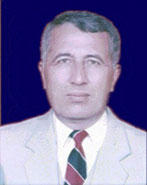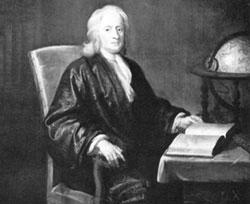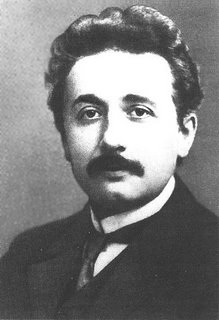*Z*I*Y*A_A*X*U*N*D*O*V*
Wednesday, June 14, 2006
Yeni Zellandiyaya köçmüş Şotlandiyalı bir ailenin 12 uşağından dördüncüsü idi. Atası (bir az loru dilde desek) teker yamayan işleyirdi. Ernest litseyi dövlet hesabına oxuyurdu. Yene de tehsilini dövlet hesabına davam etdirdiyi Christchurch-dakı Canterbury College-den 1892-ci ilde lisans(bakalavr), ertesi il ise yüksek lisans(magistr) derecelerini aldı. Canterbury College-da bir il de qaldıqdan sonra demirin yüksek tezlikli maqnetik mühitlerde maqnitleşme xüsusiyyetleri üzerinde tedqiqatlar apardı. Hertz-in bir neçe il evvel tapmış olduğu elektromaqnit dalğalarını qeyde ala bilen dedektor ixtira etdi.
1895-ci ilde ingiltereye geden Rutherford Cambridge Universitetinde Cavendish Laboratoriyasında J.J. Thomson-un yanında çalışmağa başladı. Burada elektromaqnetizm üzerindeki tecrübelerini davam etdirdi ve Hertz dalğalarını 3 km uzaqlıqdan gönderib almağı bacardı. 1895-ci il Wilhelm Conrad Röntgen-in X şüalarını tapdığı açıqlamasından sonra J.J. Thomson ve Rutherford bu sahede çalışmağa başladılar.
XIX yüz illiyin sonuna gelerken bir çox elm adamı artıq fizikada bundan sonra keşf edilecek bir şey qalmadığı fikrinde idi. Ancaq Rutherford 3 il içerisinde fizikanın yeni bir sahesini ortaya çıxardı: Radioaktivlik. Radioaktivliyin fiziki menasını bir elementin atomunun diger bir elementin atomuna özbaşına çevrilmesi kimi başa düşürdü. Maddenin deyişmezliyi fikrine tam bağlanan alimler bu ideyaya qarşı çıxacaqdı ancaq Rutherford-un bu ideyası sonradan göründüyü kimi öz doğruluğunu isbat edecekdi.
Bu böyük uğurun ardından Rutherford 1903-cü ilde Royal Society-in müxbir üzvü seçildi. Bir il sonra ise Royal Society-in böyük bacarığı olan elm adamlarına verdiyi Rumford Medalı ile teltif edildi. α zerreciklerinin elektrik ve maqnit sahesinde sepilmesini 1903-cü ilde tapan Rutherford bunların hem de yüklü zerrecikeler olduğunu aşkar etdi.
Rutherford-un 1911-ci ilde yaratdığı "Atom Modeli" onun elme en böyük emeyidir. Atomun bu modeline “Rutherford Atom Modeli” ya da “Kişmişli Atom Modeli” deyilirdi.
Elementlerin radioaktiv parçalanması ve radioaktiv maddelerin kimyası sahesindeki tedqiqatlarına göre 1908-ci ilde kimya sahesinde Nobel mükafatına layiq görülmüşdür. 1914-cü ilde Ernest Rutherford-a Baron adı verildi ve 1922-ci ilde Royal Society-nin en böyük mükafatı olan Copley Medalı ile teltif edilmişdi. 1922-ci ilde Royal Society-nin prezidenti vezifesine keçdi.
E.Retherford 1937-ci ilde oktyabrın 19-da İngilterenin Cambridge şeherinde vefat etmişdir.
Sunday, June 04, 2006
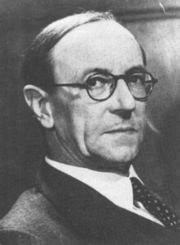
James Chadwick
James Chadwick 1891-ci il oktyabrın 20-de İngilterenin Cheshire şeherinde anadan olmuşdur. James milliyetce ingilisdir. Tehsilini Rutherford-un telebesi kimi Manchester Universitetinde aldı. 1919-cu ilde çalışmağa başladığı Cambridge Universitetinde 1935-ci ile qeder oradakı işine davam etdi. Esas elmi işleri nüve fizikasının problemleri olmuşdur.
1923-cü ilde Cavendish Laboratoriyasının Tedqiqatlar şöbesinin müdürü vezifesine keçmişdir.
1927-ci ilde ise Royal Society-nin müxbir üzvü seçildi.
1932-ci ilde neytronu keşf etdi ve 3 il sonra bu keşfine göre 1935-ci ilde Nobel mükafatı laureatı adına layiq görülmüşdür. Bundan başqa 1935-ci ilde Liverpool Universitetinin fizika kürsüsüne keçdi. İkinci Dünya Müharibesi dövründe Los Alamos-dakı atom tedqiqatlarına başçılıq etdi. 1948-ci ilde Cambridge-deki bir kollecin müdürü vezifesine keçdi. Deteryumun qamma şüaları ile parçalanmasını tedqiq ederek nüve fotoelektrik effektini tapdı.
James Chadwick 24 iyul 1974-cü ilde Cambridge-de vefat etdi.
in english
James Chadwick
Sir James Chadwick (October 20, 1891 – July 24, 1974) was an English physicist and Nobel laureate.Chadwick was born at Cheshire the 20th of October 1891. He went to Manchester High School, (England) and studied at the Universities of Manchester and Cambridge. His father was John Joseph Chadwick and his mother was Mary Anne Knowles.
In 1914 Chadwick went to work with Hans Geiger at the Technische Hochschule in Berlin (today the Technical University of Berlin). He also worked with Lord Rutherford. During the First World War Chadwick was interned in Germany as an enemy alien.
After the war Chadwick returned to Cambridge where he worked with Ernest Rutherford in investigating the emission of gamma rays from radioactive materials. They also studied the transmutation of elements by bombarding them with alpha particles, and investigated the nature of the atomic nucleus.
In 1932 Chadwick made a fundamental discovery in the domain of nuclear science: he discovered the particle in the nucleus of an atom that became known as the neutron because it has no electric charge. In contrast with the helium nuclei (alpha particles) which are positively charged, and therefore repelled by the considerable electrical forces present in the nuclei of heavy atoms, this new tool in atomic disintegration need not overcome any electric barrier and is capable of penetrating and splitting the nuclei of even the heaviest elements. In this way, Chadwick prepared the way towards the fission of uranium 235 and towards the creation of the atomic bomb. For this epochal discovery he was awarded the Hughes Medal of the Royal Society in 1932, and subsequently the Nobel Prize for Physics in 1935. Later, he found out that a German scientist had discovered the neutron at the same time. But Hans Falkenhagen (Rostock) was afraid of publishing his results. When Chadwick learned of Falkenhagen's discovery, he offered to share the Nobel Prize with him. Falkenhagen, however, modestly refused the honour.
Chadwick’s discovery made it possible to create elements heavier than uranium in the laboratory. His discovery particularly inspired Enrico Fermi, Italian physicist and Nobel laureate, to discover nuclear reactions brought by slowed neutrons, and led Lise Meitner, Austrian physicist, to the discovery of “nuclear fission”, which triggered the development of an atomic bomb..
He died in Cambridge the 24th of July 1974.
Wednesday, May 24, 2006
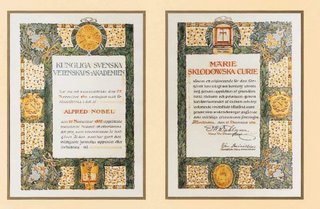 Marie Curie
Marie Curie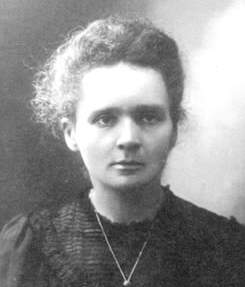
At the Sorbonne she met and married another instructor, Pierre Curie. Together they studied radioactive materials, particularly the uranium pitchblende ore, which had the curious property of being more radioactive than the uranium extracted from it. By 1898 they deduced a logical explanation: that the pitchblende contained traces of some unknown radioactive component which was far more radioactive than uranium; thus on December 26th Marie Curie announced the existence of this new substance.
Over several years of unceasing labour they refined several tons of pitchblende, progressively concentrating the radioactive components, and eventually isolated initially the chloride salts (refining radium chloride on April 20, 1902) and then two new chemical elements. The first they named polonium after Marie's native country, and the other was named radium from its intense radioactivity. Maria Skłodowska Curie Nobel Prize Diploma
In 1903 she became the first woman in France to complete her doctorate.
Together with Pierre Curie and Henri Becquerel, she was awarded the Nobel Prize in Physics, 1903: "in recognition of the extraordinary services they have rendered by their joint researches on the radiation phenomena discovered by Professor Henri Becquerel". She was the first woman to be awarded a Nobel Prize. Eight years later, she received the Nobel Prize in Chemistry, 1911 "in recognition of her services to the advancement of chemistry by the discovery of the elements radium and polonium, by the isolation of radium and the study of the nature and compounds of this remarkable element". In an unusual move, Curie intentionally did not patent the radium isolation process, instead leaving it open so the scientific community could research unhindered. Just one month after accepting her 1911 Nobel Prize, Marie was hospitalized with depression and kidney trouble.
She was the first person to win or share two Nobel Prizes. She is one of only two people who has been awarded a Nobel Prize in two different fields, the other being Linus Pauling. As of October 2005, she remains the only woman to win two Nobel prizes.
After her husband's death, she supposedly had an affair with physicist Paul Langevin, a married man who had left his wife, which resulted in a press scandal, exacerbated by her academic opponents in order to damage her credibility. Despite her fame as an honored scientist working for France, the public's attitude to the scandal tended towards xenophobia — she was a foreigner, from an unknown land (Poland was still referred to as a geographical area, under the Russian Tsar), an area known to have a significant Jewish population (Marie was an atheist, raised as a Catholic, even born in a gentry family [ Dołęga-Sklodowski], but that didn't seem to matter). France at the time was still reeling from the effects of the Dreyfus affair etc, so the scandal's effect on the public was all the more acute. It is a strange coincidence that Paul's grandson Michel later married her granddaughter Hélène Langevin-Joliot.
During World War I, she pushed for the use of mobile radiography units for the treatment of wounded soldiers. These units were powered using tubes of radium emanation, a colorless, radioactive gas given off by radium, later to be identified as radon. Marie personally provided the tubes, derived from the radium she purified. Promptly after the war started, she donated her and her husband's gold Nobel Prize Medals for the war effort.
In 1921, she toured the United States, where she was welcomed triumphantly, to raise funds for research on radium.
In her later years, she was disappointed by the myriad physicians and makers of cosmetics who used radioactive material without precautions.
Her death near Sallanches in 1934 was from aplastic anemia, almost certainly due to her massive exposure to radiation in her work, much of which was carried out in a shed with no proper safety measures being taken, as the damaging effects of hard radiation were not generally understood at that time. She was known to carry test tubes full of radioactive isotopes in her pocket, and to store them in her desk drawer, resulting in massive exposure to radiation. She was known to remark on the pretty blue-green light the metals gave off in the dark. Historical 20 000 złoty banknote of Poland with face of Maria Skłodowska Curie
Her eldest daughter, Irène Joliot-Curie, won a Nobel Prize for Chemistry in 1935.
Tuesday, May 23, 2006

İBNI SİNA
İbni Sina ve ya Ave Sina 980-ci il Avqust ayında Müselman İmperiyasinin erazisinde Buxarada dünyaya göz açdı. O hem filosof, riyaziyyatçı, fizik, şair idi. Bundan başqa onun tibb elminde böyük emeyi var. İbni Sina(Ave Sina) felsefeye aid 68, astronomiyaya aid 11, tibb elmine 16 ve şeriyyata aid ise 4 kitab yazmışdır. Öz dövründe “Hekimlerin Şahzadesi” (“The Prince of Physicians”) kimi tanınırdı
. Astrologiya ve simyaya etibar etmeyib Deyişilme Nezeriyyesinin doğru olub olmadığını apardığı tecrübelerle tedqiq etmiş ve doğru olmadığını isbat etmişdir. İbni Sinaya göre, her element yalnız özüne xas keyfiyyetlere malikdir ve belelikle daha deyersiz metallardan qızıl ve gümüş kimi daha deyerli metalların elde edilmesi mümkün deyil.
İbni Sina, mexanika ile de maraqlanmış ve bezi cehetlerden Aristotelin hereket anlayışını tenqid etmişdir. Aristotel, cismi hereket etdiren qüvve ile cisim arasındakı toxunma yox olduqda, cismin hereketini davam etdirmesini temin eden amilin şerait, yeni hava olduğunu bildirir ve havaya, biri cisme müqavimet digeri ise cismi daşıma olmaq kimi bir-birine uzaq olan iki vezifeni yükleyirdi.
İbni Sina, bu zidd durumu sezmiş, apardığı müşahideler neticesinde hava ile küleyin güclerini müqayise etmiş ve Aristotelin haqlı ola bilmesi üçün havanın şiddetinin küleyin şiddetinden daha çox olması neticesini çıxarmışdır. Ancaq bir ağacın yaxınından ötüb keçen bir ox, ağaca deymediyi müddetce, ağacda ve yarpaqlarında en xırda bir terpenme meydana getirmediyi halda, külek, ağacları silkelemekde ve hetta kökünden qopara bilmekdedir. Ele ise havanın şiddeti cisimleri daşımaq üçün kifayet deyil.
İbni Sina, her şeyden önce hekimdir ve bu sahedeki tedqiqatları ile meşhurdur. Tible elaqeli bir çox eser qeleme almışdır; bunlar arasında xüsusile ürek-damar sistemi ile elaqeli olanlar diqqete layiqdir. Ancaq İbnii Sina dedikde, onun adı ile bütünleşmiş ve Qerb ölkelerinde 16-cı esrin ve Şerq ölkelerinde ise 19-cu esrin evvellerine qeder oxunmuş ve istifade edilmiş “El Qanun fit Tibb” adlı eseri yadımıza düşür.
Beş kitabdan ibaret bu ensiklopedik eserin birinci kitabı, anatomiya ve qoruyucu hekimlik; ikinci kitabı adi dermanlar; üçüncü kitabı patologiya; dördüncü kitabı dermanlar ve cerrahi metodlarla müalice; beşinci kitabı ise müxtelif derman terkibleri ile elaqeli tefsilatlı melumatlar verilmişdir.
İbni Sinanın bu eseri araşdırıldıqda, mövzuları sistematik bir formada tedqiq edildiyi nezere çarpır. Tarixde ilk defe tibb ve cerrahiyyeni iki ayrı qayda-qanun kimi qiymetlendiren İbnii Sina, cerrahi müalicenin düzgün aparılması üçün anatomiyanın vacibliyini xüsusi vurğulamışdır. Heyat tehlükesi çox yuxarı olduğu üçün debde olmayan cerrahi müalice ile elaqeli nümuneler vermiş ve emeliyyatlarda istifade etmek üçün bezi aletler teklif etmişdir.
Göz ile de maraqlanmış İbni Sina, dövrünün seçilen fiziklerinden İbni Heysem kimi, Göz-Şüa Nezeriyyesini müdafie etmiş ve üst göz qapağının xarice çıxması, davamlı ağ renge ve ya qara baxmaqdan meydana gelen qar korluğu kimi daha önce behs edilmeyen xestelikler haqqında da tefsilatlı izahlar vermişdir.
İbni Sina 21 İyun 1037-ci ilde Hemedanda vefat etdi.
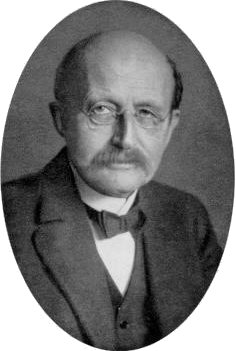
Max Planck
Max Karl Ernst Ludwig Planck 23 aprel 1858-ci ilde Almaniyanin Kiel şeherinde ziyali bir ailede dünyaya geldi. Atasi Kiel Universitetinde hüquqşunas işleyirdi. Orta tehsilini Münihde Max Millian Litseyinde aldi. Elme könül vermiş bir müelliminin tesiri ile Max-in fizikaya maraği daha da artirdi. Bir terefden de ailesinin tekidi ile piano dersleri alirdi.
Fizikani öyrenmek üçün Universitete gederken, öz dövrünün böyük fiziki Hermann Helmholtz : “fizikada bundan sonra edilecek çox bir şey qalmayib, inkişaf etmek üçün başqa bir elm sahesini seçsen daha yaxşi olar” demişdi. Ancaq Max öz uşaqliq xeyallarindan el çekmek fikrinde deyildi. Bir terefden de Universitetde oxuyan zaman Helmholtz ve Kirchhof kimi böyük alimlerden tehsil almağin onun üçün böyük bir fürset olduğunu düşünürdü.
Münih ve Berlin universitetlerinde tehsilini davam etdiren genc fizik Planck qisa bir müddetde etrafindaki insanlarin diqqetini celb etdi ve otuz yaşinda Berlin Universitetinde fizika kürsüsüne çixir.
1889-cu ilde Berlin Universitetinde Kirchhof-un yerini aldi ve 1926-ci ile qeder bu vezifede qaldi. 1918-ci ilde enerjinin kvantlanmasi ile bağli keşfine göre Nobel mükafatina layiq görüldü.
Planckin heyati facielerle dolu keçib. Oğullarindan biri Birinci Dünya Müharibesinde öldürüldü ele hemin illerde iki qizi uşaq doğan zaman öz heyatlarini itirdiler. Evi İkinci Dünya Müharibesi zamani bobardiman edildi. Oğlu Erwin Hitlere suiqest hazirlamaqda günahlandirilaraq 1944-cü ilde edam edildi. Edam etmezden evvel “Nazileri destekleyerse oğlunun efv edileceyini bildirmişdiler” ancaq o bu teklifi oğlunun ölümü bahasina olsa da redd etdi. Ömrünün son iki ilini Höttingende sayilib-seçilen elm adamlarindan biri olaraq İnsan Hüquqlarinin Müdafieçisi kimi keçirdi. Max Planck oktyabirin 4-ü 1947-ci ilde 89 yaşinda vefat etdi.
Planck came from a traditional, intellectual family. His paternal great-grandfather and grandfather were both theology professors in Göttingen, his father was a law professor in Kiel and Munich, and his paternal uncle was a judge.
Max Planck was born in Kiel to Johann Julius Wilhelm Planck and his second wife, Emma Patzig. He was the sixth child in the family, though two of his siblings were from his father's first marriage. Among his earliest memories was the marching-in of Prussian and Austrian troops into Kiel during the Danish-Prussian war 1864. In 1867 the family moved to Munich, and Planck was enrolled in Munich's Königliches Maximiliansgymnasium, where he came under the tutelage of Hermann Müller, a mathematician who took an interest in the youth and taught him astronomy and mechanics as well as mathematics. It was from Müller that Planck first learned the principle of conservation of energy. Planck graduated early, at age sixteen.[edit]
Education
Planck was very gifted when it came to music: he took singing lessons in addition to playing the piano, organ and cello, and composing songs and operas. However, instead of music he chose to study physics.
The Munich physics professor Philipp von Jolly advised him against going into physics, saying, "in this field, almost everything is already discovered, and all that remains is to fill a few holes." Planck replied that he did not wish to discover new things, only to understand the known fundamentals of the field, and began his studies in 1874 at the University of Munich. Under Jolly's supervision, Planck performed the only actual experiments of his scientific career (studying the diffusion of hydrogen through heated platinum), but soon transferred to theoretical physics.
In 1877 he went to Berlin for a year of study with the famous physicists Hermann von Helmholtz and Gustav Kirchhoff and also the mathematician Karl Weierstrass. He wrote that Helmholtz was never quite prepared, spoke slowly, miscalculated endlessly, and bored his listeners, while Kirchhoff spoke in carefully prepared lectures, which were, however, dry and monotonous. Despite this he soon became close friends with Helmholtz. While there he mostly undertook a program of self-study of Clausius's writings, which led him to choose heat theory as his field.
In October 1878 Planck passed his qualifying exams and in February of 1879 defended his dissertation, Über den zweiten Hauptsatz der mechanischen Wärmetheorie (On the second fundamental theorem of the mechanical heat theory). He briefly taught mathematics and physics at his former school in Munich.
In June 1880 he presented his habilitation thesis, Gleichgewichtszustände isotroper Körper in verschiedenen Temperaturen (Equilibrium states of isotropic bodies at different temperatures).
In 1946, he travelled to London on the occasion of the 300th birthday of Isaac Newton. He was the only German invited. On 1 April 1946, Planck was succeeded as president of the KWG by Otto Hahn. On 4 October 1947, he died, aged 89, from the consequences of a fall and several strokes.
Monday, May 22, 2006
Xestelikden qorunmaq meqsedi ile anasinin yanina siginan Nyuton burada kecirdiyi iki il boyunca en onemli ideyalarini gerceklesdirdi. 1667-ci ilde Trinity Kollecine qayitdigi zaman differensial ve inteqral hesabin temellerini qoymus , ag isigin rengli spektrlere ayrilmasini mueyyenlesdirmis ve cisimlerin bir-birlerini aralarindaki mesafenin kvadrati ile ters mutenasib olaraq cezb etdiklerini fikrine gelmisdir. Cekingenliyi uzunden Nyuton her bir elmde boyuk deyisiklik yarada bilecek bu kesflerin coxunu uzun iller sonra ( meselen differensial ve inteqral hesablari 38 il sonra) uze cixarmisdir. Nyuton 1669-cu ilde hele 27 yasi olanda Cambridge Universitetinde riyaziyyat professoru kimi calismaga basladi . 1671-ci ilde ilk aynali teleskopu ixtira etdi ve ertesi il Royal Society-in uzvu secildi .Royal Society-ye teklif etdiyi reng haqqinda fikirlerinin tenqidlere hedef olmasi , xususen de Robert Hooke terefinden siddetli tenqidlere meruz qalmasi Nyutonun ozune qapanaraq elm dunyasindan elaqesini tamamile kesmeye getirib cixardi. 1675-ci ilde yeniden teklif etdiyi optik movzusundaki iki fikri yeni munaqiselere yol acdi. Hooke meqalelerde bezi tapintilarin oz kesfi oldugunu, Nyutonun bunlara sahib cixdigini soylemisdi. Butun bu munaqiseler ve tenqidler neticesinde 1678-ci ilde ruhi sarsinti keciren Nyuton ancaq yaxin dostu, meshur astronom, riyaziyyatci Edmond Halleyin xahisi ile alti il sonra elmi calismalarina geri dondu.
Cambridge Universitetindeki katolikliyi yaymaga qarsi yoneldilen herekata basciliq eden Nyuton , Kral dusuruldukden sonra 1689-cu ilde universitetin parlamentindeki temsilciliyine secildi. 1693-cu ilde yeniden ruhi sarsinti kecirdi ve yaxin dostlari ile , bu arada Samuel Pepys ve John Locke ile arasi pozuldu. Iki il davam eden ruhi sarsintidan sonra sagligina yeniden qovussa da bundan sonraki heyatinda elmi calismalara evvelki kimi maraq gostermedi . Daha sonra 1699-cu ilde Fransa Elmler Akademiyasinin xarici uzvuluyune , 1703-cu ilde Royal Society-nin bascisi secildi.
Gelmis kecmis elm adamlarinin en boyuklerinden biri olaraq qebul edilen Nyuton riyaziyyat ve fizikada cox onemli kesfler etmisdi. Nyutonun elme en boyuk komeyi mexanikadadir. Merkezeqacma quvvesi qanunu ile Kepler qanunlarini ele alaraq kutleceki qanununu ortaya qoydu.
Nyutonun kitablarindan bezileri Philosophiae naturalis principia mathematica, principia , opticks sayila biler.Nyuton hec vaxt evlenmeyib.
in english:
SIR ISAAC NEWTON
English scientist, astronomer and mathematician Born in 1642 - Died in 1727
Sir Isaac Newton when he was a boy, was more interested in making mechanical * devices than in studying. He made a windmill that could grind wheat and corn, and he made a water clock and a sundial. His teachers thought of him as a poor student. He wanted to go to college, but he didn't have the money to go. He enrolled at the lowest entry. In this position he had to serve the other students by running errands for them. He even ate the leftovers of their meals, but he would do anything to get an opportunity to learn. Even when he was in college, he was not outstanding and received no awards. When the university shut down because of the plague, he went home and continued to study on his own. He had a notebook with 140 blank pages and he began to fill them with notes as he read and experimented. His childlike curiosity led him to make some very important discoveries when he became a man. Within a period of a year and half he made three great discoveries. One day when he was drinking tea in the garden, he saw an apple fall to the ground. He started thinking about why it fell, and finally concluded that the same force that caused the apple to fall also kept the moon in orbit around the earth. This same force, gravity, * also kept the planets in orbit around the sun. The apple incident led to his three basic laws of motion: An object in motion tends to remain in motion unless an external force stops it; an object moves in a straight line unless some force diverts it; for every action, there is an equal and opposite reaction. He didn't publish his findings for a long time. Edmund Halley, an astronomer, * urged him to publish the things he had learned. His second discovery was about light and the properties of light. He spent months in a darkened room doing experiments. He passed a beam of sunlight through a prism and found that the beam of light was broken down into different colors. He concluded that something that appears green, such as grass, looks green because it reflects the green light in the sun and absorbs most of the other colors. Some of his experimenting was dangerous. He would look at the sun, (something his mother had told him never to do), and he would stare at the reflection of the sun in a mirror until he lost his sight. Then he shut himself up in a dark room for several days until his vision finally returned. He also made a reflecting telescope to use in his studies. Newton's third great discovery was in the field of math when he developed a kind of math we call calculus * . He was just 24 years old at the time. However he did not publish his findings for about 20 years, and by that time someone else had figured out the same thing. Newton said the man had stolen his idea. There was a bitter debate over which man made the discovery . Newton got his friends to say that he was the one. However, 200 years later, it was decided that both men had come to the same conclusion without help from the other one. By the time he was in his mid 50's he had worn himself out and suffered from exhaustion. Some were even afraid he might have mercury poisoning caused by his experiments. In 1696 he became the head of the mint where the coins were made. There was a lot of counterfeiting * . People were making their own coins. So the mint started replacing all the coins with new coins. Newton would dress up in disguises so that no one would know him, and he would go out on the streets of London to try and catch the counterfeiters. He was successful in capturing the people who were responsible. Sir Isaac Newton never married. It is said that he was very generous with his nieces and nephews and with the scientists who helped him in his work.
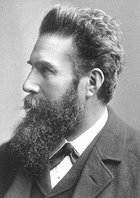 Wilhelm Conrad Röntgen
Wilhelm Conrad RöntgenEslen Alman fiziki olan Wilhelm Conrad Röntgen 27 mart 1845-ci ilde Lennepde(Remscheid) doğuldu ve 10 fevral 1923-cü ilde Münihde öldü. Uşaqlığı ve mektebli illeri Hollandiyada ve İsveçrede keçdi. Zürihde universitet tehsili gördü. 1876-cı ilde Strassburgda , 1879-cu ilde Giessen ve 1888-ci ilde Würzburg universitetlerinde fizika professoru kimi çalışdı. Rentgen 1895-ci ilde keşf etdiyi X-şüalarına göre böyük şöhret qazanmışdır. Rentgen X-şüalarını inceleyen zaman elektrik ve maqnit sahelerinin tesiri ile istiqametini deyişmediyini isbat etmişdir. Bu şüaların cisimlerin daxilinden keçme qabiliyyetine malik olduğunu ve havanı ionlaşdırdığını ortaya çıxardı. 1901-ci ilde tamamladığı bu araşdırmalarına göre fizika sahesinde ilk nobelçi fizik adına layiq görüldü. Ölümünden sonra X-şüalarına Rentgen şüaları adı verildi.
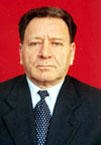 Akademik
AkademikESGEROV BEHRAM MEHRELI OGLU
Anadan oldugu yer: Azerbaycan Respublikasi,Tovuz rayonu Ehmedabad kendi
Tevelludu: 05.10.1933
Tehsili: Azerbaycan DovletUniverseti,fizik
Elmi derecesi: Fizika-riyaziyyat elmleri doktoru
Elmi rutbesi: Professor
Doktorluq dissertasiyasinin ixtisas sifri ve ixtisasinin adi: 01.04.07-Berk cisimler fizikasi
Muxbir uzv secildiyi tarix ve ixtisasin adi: 2001,fizika
Capdan cixmis elmi eserlerinin sayi: 105
Xaricde cixmis elmi eserlerinin sayi: 80
Esas elmi nailiyyetleri: Esas elmi istiqameti-Berk cisimlerde kocurme hadiselerinin klassik ve kvant nezeriyyesine aiddir.Berk cisimlerde kvantlayici maqnit sahesi olduqda dissipativ termomaqnit cereyan sixligini hesablamaq ucun metod teklif etmis. Termomaqnit effeklerin kvant nezeriyyesini veren alimlerden biridir. Kvaziikiolculu elektron sistemlerde kocurme hadiselerinin nezeriyyesini verib.
Kadr hazirligi:
elmler namizedlerinin sayi: 12
elmler doktorlarinin sayi: 3
Esas elmi eserlerinin adlari:
1. "Кинетические эффекты в полупроводниках" (Монография),20 п.л. Ленинград,Наука,1970
2, "Электронные явления переноса в полуправодниках". 22 п.л. (Монография), Москва Наука,1985
3."Electron transport Phenomena in Semiconductors" (Монография), Singapore , London, 1994
4. Electron transport Solidi, v.121, pp. 11-37, Berlin, 1984
5. Уравнение Состояния электронного газа и теория термоэде в квантующем магнитном поле , ФТП , т. 32, N=3, 1998
Teltif ve mukafatlar: Azerbaycan Respublikasi Dovlet Mukafati-1974;
Emekdar Elm Xadimi-2000
Azerbaycan Respublikasinin "Sohret" ordeni-2004.
Pedaqoji fealiyyeti: 1966-ci ilden dosent 1972-ci ilden professor 1971-ci ilden kafedra mudiri
Is yeri ve unvani: Baki Dovlet Universiteti, AZ1143, Azerbaycan Respublikasi Baki s., Z.Xelilov kuc., 23
Vezifesi: Kafedra mudiri
Xidmeti tel.: (994 12) 4381554
Ev tel.: (994 12) 4395576
Mobil tel.: (994 50) 2130781
Faks: (994 12) 4983376
Elektron poctu: Bahram.Mehrali@rambler.ru
 Galileo Galilei
Galileo GalileiGalileo Galilei (1564-1642), muasir fizikanin ve teleskopik astronomiyanin banilerinden olan Italiyan elm adamidir. 1564-ci ilde Italiyanin Pisa seherinde anadan olub. Zemanesinin taninmis musiqicilerinden Vincenzo Galilei-nin oglu olan Galileo, ilk tehsilini Floransada almisdi. 1581-ci ilde Pisa universitetinde tibb tehsiline basladi, ancaq imkansizliqdan ( pulu olmadigindan) universiteti terk etdi. 1583-cu ilden riyaziyyata maraq gosteren Galileo , bu sahede calismalari neticesinde 1589-cu ilde Pisada professor oldu.
Uzen cisimlerin ve hereketin Aristotel fizikasindan ferqli bir dusunce ile riyazi olaraq ele alinmasi lazim olduguna inanan Galileo, Pisa qalasindan agirliq dusurderek Aristotelin sehv fikirde oldugunu gosterdi. Bu hereketi yasli professorlarin anlamamasina sebeb oldu. 1529-cu ilde Pisani terk ederek , Padova Universitetine geldi.
1600-cu ilde termometr, insan ureyinin doyuntulerini qeyde alan saygac ve 1604-cu ilde serbest dusmenin riyazi qanunlarini kesf etdi. 1609-cu ilde Hollandiyada teleskopun tapildigini esitdi, Bundan sonra ozu daha mukemmel teleskop duzelderek astronomiyada istifade etmeye basladi.
1610-cu ilde aydaki daglar ve. s . ucun ilk musahidelerini apardi.
1611-ci ilde Romaya getdi ve ordaki Elmler Akademiyasinin uzvu secildi. Floransaya donduyu zaman hidrostatik ucun bir cox professorun etirazina sebeb olan kitabi ile 1613-cu ilde gunes lekeleri ucun yazdigi eserini cap etdirdi. Bu eserinde Kopernik sistemini aciq sekilde mudafie etdi. 1615-ci ilde Romaya gederek oz fikrini mudafie etdi. Ancaq 1616-ci ilde Papa Besinci Paul terefinden Galileonun kitablarini yoxlamaq ucun komissiya quruldu .Bu komissiya Galileonun kitablarina qadaga qoymadi .Sadece dunyanin donmesi iddiasindan el cekmesini istedi.
Galileo , bir muddet elmin praktik terefine dondu , mikroskopu inkisaf etdirdi. Ancaq 1618-ci ilde uc quyruqlu ulduzun gorunmesi ile kilse ile munaqiseye girdi. Dostunun Sekkizinci Urban olaraq Papa secilmesinden cesaret alaraq yazdigi “Iki kainat sistemi uzerinde danisiqlar” adli eserini 1632-ci ilde cap etdirdi. Ancaq kitabi daha evvel edilen xeberdarliqlara zidd oldugunda gore Roma mehkemesine cagirildi. 1633 –cu ilde bu kitab qadagan edildi ve Galileonun ozu de hebs edildi.
Yetmis yasinda hebs edilen Galileonun gozleri kor oldu ve 1642-ci ilde hebsde olarkan oldu.
in english
Galileo Galilei
Galileo Galilei was an Italian physicist and astronomer. He was born in Pisa on February 15, 1564. Galileo's father, Vincenzo Galilei, was a well-known musician. Vincenzo decided that his son should become a doctor.
In 1581, Galileo was sent to the University of Pisa to study medicine. While a student at the university, Galileo discovered that he had a talent for mathematics. He was able to persuade his father to allow him to leave the university to become a tutor in mathematics. He later became a professor of mathematics.
In 1609, Galileo heard about the invention of the spyglass, a device which made distant objects appear closer. Galileo used his mathematics knowledge and technical skills to improve upon the spyglass and build a telescope. Later that same year, he became the first person to look at the Moon through a telescope and make his first astronomy discovery. He found that the Moon was not smooth, but mountainous and pitted - just like the Earth! He subsequently used his newly invented telescope to discover four of the moons circling Jupiter, to study Saturn, to observe the phases of Venus, and to study sunspots on the Sun.
Galileo's observations strengthened his belief in Copernicus' theory that Earth and all other planets revolve around the Sun. Most people in Galileo's time believed that the Earth was the center of the Universe and that the Sun and planets revolved around it.
The Catholic Church, which was very powerful and influential in Galileo's day, strongly supported the theory of a geocentric, or Earth-centered, Universe. After Galileo began publishing papers about his astronomy discoveries and his belief in a heliocentric, or Sun-centered, Universe, he was called to Rome to answer charges brought against him by the Inquisition (the legal body of the Catholic Church). Early in 1616, Galileo was accused of being a heretic, a person who opposed Church teachings. Heresy was a crime for which people were sometimes sentenced to death. Galileo was cleared of charges of heresy, but was told that he should no longer publicly state his belief that Earth moved around the Sun. Galileo continued his study of astronomy and became more and more convinced that all planets revolved around the Sun. In 1632, he published a book that stated, among other things, that the heliocentric theory of Copernicus was correct. Galileo was once again called before the Inquisition and this time was found guilty of heresy. Galileo was sentenced to life imprisonment in 1633. Because of his age and poor health, he was allowed to serve his imprisonment under house arrest. Galileo died on January 8, 1642.
 AKADEMIK
AKADEMIKABDULLA IBRAHIM OGLU MUXTAROV
Anadan olduğu yer: Rusiya Federasiyası, Dağıstan Muxtar Respublikası, Rutul rayonu, Saxur kendi
Tevellüdü: 24.12.1918
Tehsili: Azerbaycan Dövlet Universiteti, Fizika fakültesi, fizik-nezeriyyeçi
Elmi derecesi: Fizika-riyaziyyat elmleri doktoru
Elmi rütbesi: Professor
Doktorluq dissertasiyasının ixtisas şifri ve ixtisasın adı: 01.04.02; 01.04.16 - Nezeri-fizika, nüve-fizikası
Müxbir üzv seçildiyi tarix ve ixtisasın adı: 1972, fizika
Çapdan çıxmış elmi eserlerin ümumi sayı: 130
Xaricde çıxmış elmi eserlerin sayı: 50
Esas elmi nailiyyetleri:
1. Elmi rehberimle birge (Sokolov A.A.) Fermionları uzununa (spirallığı), fotonların xetti dairevi polyarizasiyasını nezere alan metod teklif etmişik (1948-ci il)
2. Hemin metod menim terefimden ixtiyari istiqametli polyarizasiyanı nezere almaq üçün ümumileşdirilmişdir (1963-cu il)
3. Azerbaycanda nezeri fizika mektebini yaratmışam.
4. Yüksek enerjili polyarize olunmuş zerreciklerin elektrodinamikasının yaradılmasında intensiv iştirak etmişem. İlk defe spinleri 3/2, 5/2, 7/2 ve t/2 olan zerreciklerin pronaqatorlarını qurmuşam.
5. Bu esasda ete- destelerinin fermionlara, odronlara, vozonlara, rezonanslara ve başqa zerreciklere çevrilmesi istiqametinde böyük hecmde tedqiqat işi aparılmış ve tecrübe ile müqayise edilmişdir, yaxşı uyğunluq alınmışdır.
6. Zeif-elektromaqnit qarşılıqlı tesirlerin standart modelinde ferz olunan z- bozondan elave z'-bozonun da varlığını teleb eden EtxE8 modelinde tedqiqat işleri aparılmışdır.
Kadr hazırlığı: elmler namizedlerinin sayı: 25
elmler doktorlarının sayı 4
Esas elmi eserlerin adları:
1. К теории аннигиляции электронов и позитронов, Вестник МГУ, №8, 63, 1948
2. Поляризационные эффекты при распаде p°→е-+е- +γ ЖЭТФ, 37, 575, 1959
3. Исследование электророждение нуклонных резонансов на поляризованных протонах, Nuovo Cuniento, GA, №1, 13,1971
4. Суперструнный z' бозон в радиационный е+е- аннигиляции Я.Ф. т. 58, №7, 1288-1297, 1995
Power correction to the pion-photon transition form factor Fπγ(Г2)International Journal of Modern Physics A, vol. 16, №18, (2001), 3179-3190
Teltif ve mükafatlar:
Azerbaycan SSR Ali Sovetinin Fexri Fermanı - 1969; "Leninin anadan olmasının 100 illiyi ile elaqedar. Şerefli emeye göre" medalı - 1970; "1974-cü il sosialist yarışının qalibi" - 1974; "Azerbaycan SSR xalq tehsili elaçısı" medalı - 1975 "Şeref nişanı" ordeni - 1978; "SSRİ-nin tehsil elaçısı" medalı - 1980; "emek veteranı" medalı - 1981; Azerbaycanın emekdar Elm Xadimi - 1992; Azerbaycan Respublikasının "Şöhret" ordeni - 1998; BDU-nun "Xatire" medalı – 1998
Pedaqoji fealiyyeti: 1950-ilden Bakı Dövlet Universitetinde baş müellim, dosent, professor işleyirem. İki tedris kitabının müellifiyem. "Statistik fizika", 1961-ci il, "Kvant mexanikası", 1999-cu il.
İş yeri ve ünvanı: Bakı Dövlet Universiteti, Azerbaycan Respublikası, Bakı ş., Z.Xelilov küç.,23
Vezifesi: Professor (nezeri fizika kafedrası).
Xidmeti tel.: (994 12) 4390213
Ev tel.: (994 12) 4934051
Elektron poçtu: mukharov@dcacs.ab.az
Thursday, January 12, 2006
Friday, January 06, 2006

Nobelçi fizikler
1901 Wilhelm Conrad Röntgen (Almaniya)
1902 Hendrik A. Lorentz (Hollandiya)
1902 Pieter Zeeman (Hollandiya)
1903 Antoine Henri Becquerel (Fransa)
1903 Marie Curie (Fransa)
1903 Pierre Curie (Fransa)
1904 Lord John William Rayleigh (Böyük Britaniya)
1905 Philipp Eduard Anton Lenard (Almaniya)
1906 Sir Joseph John Thomson (Böyük Britaniya)
1907 Albert A. Michelson (ABŞ)
1908 Gabriel Jonas Lippmann (Fransa)
1909 Karl Ferdinand Braun (Almaniya)
1909 Guglielmo Marconi (Italiya)
1910 Johannes Diderik van der Waals (Hollanda)
1911 Wilhelm Wien (Almaniya)
1912 Nils Gustaf Dalén (Isveç)
1913 Heike Kamerlingh Onnes (Hollanda)
1914 Max von Laue (Almaniya)
1915 Sir William Henry Bragg (Böyük Britaniya)
1915 Sir William Lawrence Bragg (Böyük Britaniya)
1917 Charles Glover Barkla (Böyük Britaniya)
1918 Max Planck (Almaniya)
1919 Johannes Stark (Almaniya)
1920 Charles Édouard Guillaume (Fransa)
1921 Albert Einstein (Almaniya)
1922 Niels Bohr (Danimarka)
1923 Robert Andrews Millikan (ABŞ)
1924 Karl Manne Georg Siegbahn (Isveç)
1925 James Franck (Almaniya)
1925 Gustav Hertz (Almaniya)
1926 Jean Baptiste Perrin (Fransa)
1927 Arthur Holly Compton (ABŞ)
1927 Charles Thomson Rees Wilson (Böyük Britaniya)
1928 Sir Owen Williams Richardson (Böyük Britaniya)
1929 Prince Louis-Victor De Broglie (Fransa)
1930 Sir Chandrasekhara Venkata Raman (Hindistan)
1932 Werner Heisenberg (Almaniya)
1933 Paul Adrien Maurice Dirac (Böyük Britaniya)
1933 Erwin Schrödinger (Austria)
1935 Sir James Chadwick (Böyük Britaniya)
1936 Carl David Anderson (ABŞ)
1936 Viktor Franz Hess (Avusturya)
1937 Clinton Joseph Davisson (ABŞ)
1937 Sir George Paget Thomson (Böyük Britaniya)
1938 Enrico Fermi (Italya)
1939 Ernest Orlando Lawrence (ABŞ)
1943 Otto Stern (ABŞ)
1944 Isidor Isaac Rabi (ABŞ)
1945 Wolfgang Pauli (Avusturya)
1946 Percy Williams Bridgman (ABŞ)
1947 Sir Edward Victor Appleton (Böyük Britaniya)
1948 Lord Patrick Maynard Stuart Blackett (Böyük Britaniya)
1949 Hideki Yukawa (Japonya)
1950 Cecil Frank Powell (Böyük Britaniya)
1951 Sir John Douglas Cockcroft (Böyük Britaniya)
1951 Ernest Thomas Sinton Walton (İrlandiya)
1952 Felix Bloch (ABŞ)
1952 Edward Mills Purcel (ABŞ)
1953 Frits Zernike (Hollanda)
1954 Max Born (Böyük Britaniya)
1954 Walter Bothe (Almaniya)
1955 Polykarp Kusch (ABŞ)
1955 Willis Eugene Lamb (ABŞ)
1956 John Bardeen (ABŞ)
1956 Walter Houser Brattain (ABŞ)
1956 William Shockley (ABŞ)
1957 Tsung Dao Lee (Çin)
1957 Chen Ning Yang (Çin)
1958 Il´ja Mikhailovich Frank (RUSIYA-SOVET FIZIKI)
1958 Igor Yevgenyevich Tamm (RUSIYA-SOVET FIZIKI)
1958 Pavel Alekseyevich Cherenkov (RUSIYA-SOVET FIZIKI)
1959 Owen Chamberlain (ABŞ)
1959 Emilio Gino Segrè (ABŞ)
1960 Donald Arthur Glaser (ABŞ)
1961 Robert Hofstadter (ABŞ)
1961 Rudolf Ludwig Mößbauer (Almaniya/ABŞ)
1962 Lev Davidovich Landau (RUSIYA-SOVET FIZIKI)
1963 Maria Goeppert-Mayer (ABŞ)
1963 Johannes Hans Daniel Jensen (ABŞ)
1963 Eugene Paul Wigner (ABŞ)
1964 Nicolay Gennadiyevich Basov (RUSIYA-SOVET FIZIKI)
1964 Aleksandr Mikhailovich Prokhorov (RUSIYA-SOVET FIZIKI)
1964 Charles Hard Townes (ABŞ)
1965 Richard Feynman (ABŞ)
1965 Julian Schwinger (ABŞ)
1965 Shin-Ichiro Tomonaga (Japonya)
1966 Alfred Kastler (Fransa)
1967 Hans Albrecht Bethe (ABŞ)
1968 Luis Walter Alvarez (ABŞ)
1969 Murray Gell-Mann (ABŞ)
1970 Hannes Alfvén (Isveç)
1970 Louis Néel (Fransa)
1971 Dennis Gabor (Böyük Britaniya)
1972 John Bardeen (ABŞ)
1972 Leon N. Cooper (ABŞ)
1972 John Robert Schrieffer (ABŞ)
1973 Leo Esaki (Japonya)
1973 Ivar Giaever (ABŞ)
1973 Brian Davon Josephson (Böyük Britaniya)
1974 Antony Hewish (Böyük Britaniya)
1974 Martin Ryle (Böyük Britaniya)
1975 Aage Bohr (Danimarka)
1975 Ben Mottelson (Danimarka)
1975 Leo James Rainwater (ABŞ)
1976 Burton Richter (ABŞ)
1976 Samuel Chao Chung Ting (ABŞ)
1977 Philipp Warren Anderson (ABŞ)
1977 Nevill Francis Mott (Böyük Britaniya)
1977 John Hasbrouk Van Vleck (ABŞ)
1978 Pyotr Leonidovich Kapitsa (RUSIYA-SOVET FIZIKI)
1978 Arno Allen Penzias (ABŞ)
1978 Robert Woodrow Wilson (ABŞ)
1979 Sheldon Lee Glashow (ABŞ)
1979 Abdul Salam (Pakistan)
1979 Steven Weinberg (ABŞ)
1980 James Watson Cronin (ABŞ)
1980 Val Logsdon Fitch (ABŞ)
1981 Nicolaas Bloembergen (ABŞ)
1981 Arthur Leonard Schawlow (ABŞ)
1981 Kai Manne Börje Siegbahn (Isveç)
1982 Kenneth G. Wilson (ABŞ)
1983 Subrahmanyan Chandrasekhar (ABŞ)
1983 William Alfred Fowler (ABŞ)
1984 Simon van der Meer (Hollanda)
1984 Carlo Rubbia (Italya)
1985 Klaus von Klitzing (Almaniya)
1986 Gerd Karl Binnig (Almaniya)
1986 Heinrich Rohrer (Isviçre)
1986 Ernst Ruska (Almaniya)
1987 Johannes Georg Bednorz (Almaniya)
1987 Karl Alexander Müller (Isviçre)
1988 Leon Max Lederman (ABŞ)
1988 Melvin Schwartz (ABŞ)
1988 Jack Steinberger (ABŞ)
1989 Hans Georg Dehmelt (Almaniya)
1989 Wolfgang Paul (Almaniya)
1989 Norman Foster Ramsey (ABŞ)
1990 Jerome Isaac Friedman (ABŞ)
1990 Henry Way Kendall (ABŞ)
1990 Richard Edward Taylor (Kanada)
1991 Pierre-Gilles de Gennes (Fransa)
1992 Georges Charpak (Fransa)
1993 Russel Alan Hulse (ABŞ)
1993 Joseph Taylor (ABŞ)
1994 Bertram Neville Brockhouse (Kanada)
1994 Clifford Glenwood Shull (ABŞ)
1995 Martin Lewis Perl (ABŞ)
1995 Frederick Reines (ABŞ)
1996 David Morries Lee (ABŞ)
1996 Douglas Dean Osheroff (ABŞ)
1996 Robert Coleman Richardson (ABŞ)
1997 Steven Chu (ABŞ)
1997 Claude Cohen-Tannoudji (Fransa)
1997 William Daniel Phillips (ABŞ)
1998 Robert Laughlin (ABŞ)
1998 Horst Ludwig Störmer (Almaniya)
1998 Daniel Chee Tsui (ABŞ)
1999 Gerardus 't Hooft (Hollanda)
1999 Martinus J. G. Veltman (Hollanda)
2000 Zhores I. Alferov (RUSIYA-SOVET FIZIKI)
2000 Jack St. Clair Kilby (ABŞ)
2000 Herbert Kroemer (Almaniya)
2001 Eric A. Cornell (ABŞ)
2001 Wolfgang Ketterle (Almaniya)
2001 Carl E. Wieman (ABŞ)
2002 Raymond Davis jr. (ABŞ)
2002 Masatoshi Koshiba (Japonya)
2002 Riccardo Giacconi (ABŞ)
2003 Alexei A. Abrikosov (Russia/USA)
2003 Vitaly L. Ginzburg (Russia)
2003 Anthony J. Leggett (Böyük Britaniya)
2004 2David J. Gross (ABŞ)
2004 H. David Politzer (ABŞ)
2004 Frank Wilczek (ABŞ)
2005 Roy J. Glauber (ABŞ)
2005 John L. Hall (ABŞ)
2005 Theodor W. Hänsch (Almaniya)

